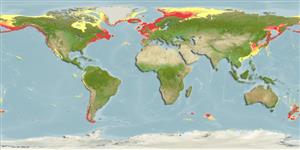Halichondria panicea (Pallas, 1766)
Bread-crumb sponge| Native range | All suitable habitat | Point map | Year 2050 |

|
| This map was computer-generated and has not yet been reviewed. |
| Halichondria panicea AquaMaps Data sources: GBIF OBIS |
Classification / Names Common names | Synonyms | CoL | ITIS | WoRMS
Demospongiae | Suberitida | Halichondriidae
Environment: milieu / climate zone / depth range / distribution range Ecology
Sessile; depth range 0 - 534 m (Ref. 119523). Temperate; 85°N - 80°S, 180°W - 180°E
Distribution Countries | FAO areas | Ecosystems | Occurrences | Introductions
Northern Pacific, Northern Atlantic, Antarctic and the Arctic.
Length at first maturity / Size / Weight / Age
Maturity: Lm ? range ? - ? cm Max length : 60.0 cm WD male/unsexed; (Ref. 865)
Filters small suspended particles, which includes free bacteria and colloidal organic matter (Ref. 96471). Trophic level 1.7-2.3 (Ref. 96418). Part of the fouling communities attached to raft frames in mariculture zones (Ref. 127121).
Life cycle and mating behavior Maturity | Reproduction | Spawning | Eggs | Fecundity | Larvae
Members of the class Demospongiae are hermaphroditic. Life cycle: The zygote develops into parenchymella larva (free-swimming) before settling down on a substrate where it grows into a young sponge.
Main reference
References | Coordinator | Collaborators
Harms, J. 1993. (Ref. 2711)
IUCN Red List Status (Ref. 130435)
CITES status (Ref. 108899)
Not Evaluated
CMS (Ref. 116361)
Not Evaluated
Threat to humans
Human uses
| FishSource |
Tools
More information
Age/Size
Growth
Length-weight
Length-length
Morphology
Larvae
Abundance
Growth
Length-weight
Length-length
Morphology
Larvae
Abundance
Internet sources
BHL | BOLD Systems | CISTI | DiscoverLife | FAO(Publication : search) | Fishipedia | GenBank (genome, nucleotide) | GloBI | Gomexsi | Google Books | Google Scholar | Google | PubMed | Tree of Life | Wikipedia (Go, Search) | Zoological Record
Estimates based on models
Preferred temperature
(Ref. 115969): 2.1 - 25, mean 9.7 (based on 2098 cells).
Price category
(Ref. 80766):
Unknown.



